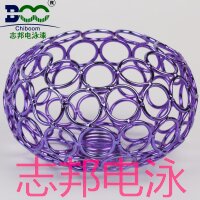How to Deal with Color Fading of Electrophoretic Paint
In the field of industrial production, electrophoretic paint is widely used in industries such as automobiles, household appliances, and hardware products due to its excellent coating performance and environmental advantages. However, the problem of color fading of electrophoretic paint often plagues many enterprises, not only affecting the appearance quality of products but also potentially reducing their market competitiveness. A thorough analysis of the causes of color fading and the adoption of targeted preventive and remedial measures are of utmost importance for ensuring product quality and enhancing enterprise benefits.

The causes of color fading of electrophoretic paint are complex and diverse. Long-term exposure to ultraviolet (UV) light is a common trigger. The UV rays in sunlight can break down the molecular structure of the electrophoretic paint coating, leading to gradual color fading. This phenomenon is particularly evident in products used outdoors, such as automobile parts and outdoor furniture, after prolonged exposure to wind and sun. Chemical erosion is also not to be overlooked. Strong acids, strong bases, and other corrosive substances can quickly trigger chemical reactions upon contact with the electrophoretic paint coating, causing discoloration and peeling. Additionally, defects in the curing process of electrophoretic paint are also a significant factor. Insufficient curing temperature or time can result in incomplete curing of the coating, with pigment molecules failing to fully cross-link, which can easily lead to color changes during use.
In response to these causes of color fading, enterprises can take preventive measures from multiple aspects. During the research and development stage of electrophoretic paint formulations, emphasis should be placed on improving UV resistance by adding special UV absorbers to enhance the coating's ability to withstand UV rays. At the same time, the ratio of pigment to resin should be reasonably adjusted to ensure the stability and weather resistance of the coating. During the production process, strict control of curing process parameters is crucial. Establishing strict standards for baking temperature and time and using advanced temperature control equipment for precise control can ensure that the coating is fully cured. In addition, strengthening production environment management, maintaining clean air in the workshop, and preventing dust and other impurities from adhering to the coating surface are important for ensuring its appearance quality.
If a product has already developed color fading issues, appropriate remedial measures should be taken based on the degree of fading. For products with slight color fading, a specialized electrophoretic paint cleaner can be used to carefully remove surface contaminants, followed by local touch-up painting with an electrophoretic paint touch-up pen. During the touch-up process, attention should be paid to matching the color with the surrounding coating to ensure that there is no obvious color difference in the repaired product. For products with moderate color fading, it is usually necessary to first sand the discolored layer to remove the damaged coating and then reapply electrophoretic coating. During reapplication, the process flow should be strictly followed to ensure coating quality. For products with severe color fading, when the adhesion of the coating is significantly reduced, mechanical or chemical paint removal methods may be required to completely remove the original coating, followed by reapplication of pre-treatment, electrophoretic coating, and other processes.
Although the problem of color fading of electrophoretic paint poses certain challenges to enterprises, through in-depth analysis of the causes and the adoption of effective preventive and remedial measures, enterprises can completely solve this problem, improve product quality, and enhance market competitiveness. In the future, enterprises should continue to explore innovation, constantly improve electrophoretic paint technology and production processes, and contribute to promoting the high-quality development of the industry.





 WeChat
WeChat